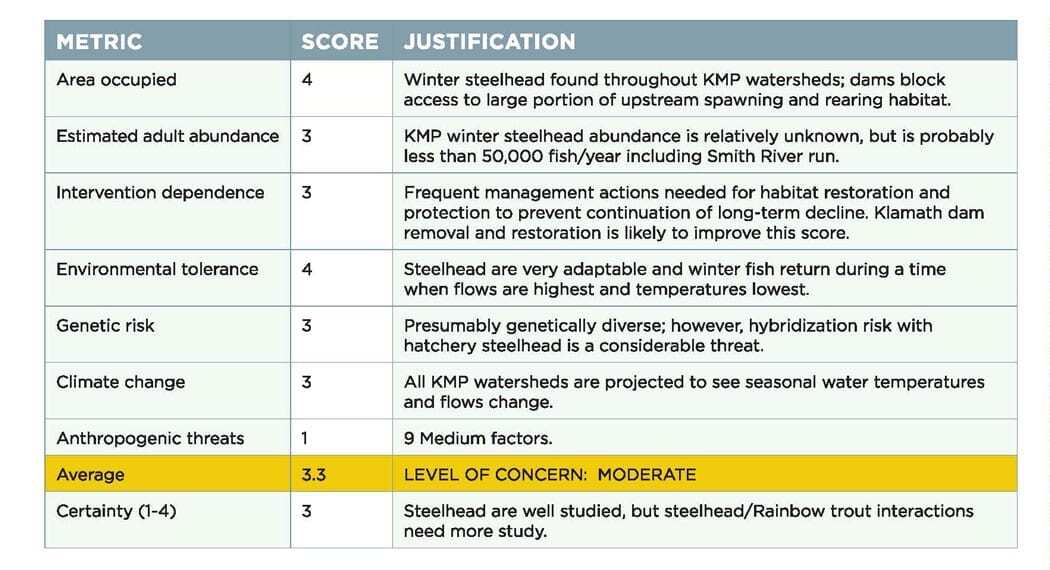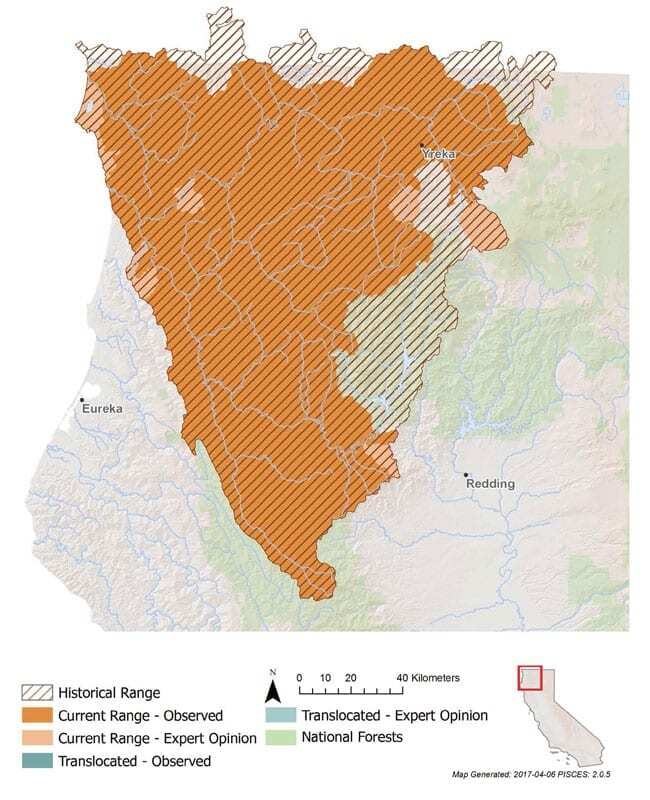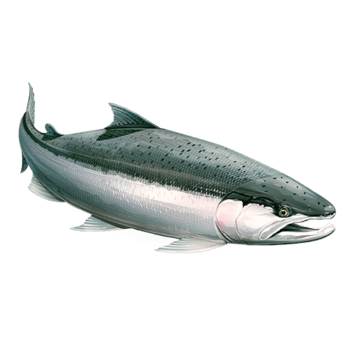How we're working to save them:
- Manage KMP winter and summer steelhead separately based on their different habitat and conservation needs.
- Remove the four lower Klamath dams to restore access to nearly 480 km (300 mi.) of historical habitat and undertake large-scale restoration.
- Use a hatchery and genetics management plan to reduce negative impacts of hatchery steelhead on remaining wild fish and protect life history and genetic diversity.
- Preserve relatively unaltered habitats, such as Blue Creek in the Klamath River Basin.
- Implement the California Coastal Salmonid Monitoring Plan to fill critical data gaps.
- Work with private and public partners to increase streamflows and reduce diversions in the Klamath Basin, especially in the Shasta and Scott rivers.
Where to find Klamath Mountains Province Winter Steelhead:
Klamath Mountains Province Winter Steelhead Distribution
The KMP winter steelhead range includes all coastal rivers and creeks throughout the Klamath-Trinity rivers basin north to the Elk River near Port Orford, Oregon. in the Klamath River, they historically ascended all major rivers and tributaries, and likely spawned in tributaries to Upper Klamath lake before the passage was blocked by a chain of dams. in the Trinity River, steelhead historically utilized each of the North, South, East, and Stuart forks of the river until Lewiston Dam blocked upstream access to much of this historical habitat.
How they Klamath Mountains Province Winter Steelhead Scored:


Characteristics
KMP winter steelhead are nearly identical in appearance to their more rare summer counterparts, but are more likely to have spawning colors in the lower reaches of rivers. Winter steelhead can be distinguished from summer steelhead in their run timing, genetics, sexual maturation, and spawning locations in mainstem rivers and tributaries.
Abundance
KMP winter steelhead returns have declined from historical estimates of approximately 220,000 fish per year to less than 50,000 fish per year, including steelhead from the Trinity River Hatchery. The presence of presumed fall-run steelhead makes accurately predicting abundance of winter steelhead difficult. The life histories, behaviors, and genetics of these fish remain the subject of ongoing research.
Habitat & Behavior
The Klamath River Basin supports the greatest diversity of steelhead life histories anywhere. KMP winter steelhead enter fresh water between November and April as mature adults. They spawn soon after arriving on spawning grounds, and migrate back to sea by March or April. One-half to two-thirds of KMP winter steelhead spawn more than once during their lives. Fry emerge from redds beginning in April, and juveniles defend territories in or below riffles where food is most abundant. Juvenile KMP steelhead can adopt one of three life histories, though the first is the most common by far: 1) spend up to two years in fresh water before migrating to sea; 2) a fresh water resident strategy (about 10% of the population); and 3) spend two to three years in fresh water before migrating to sea. Some juvenile steelhead spend two to four months in the Klamath Estuary or Pacific Ocean before returning to fresh water between August and October to over-winter. These immature fish, called “half-pounders,” are likely to survive and spawn multiple times during their life.
Genetics
Genetics KMP winter steelhead are more closely related to KMP summer steelhead than to other winter steelhead. Steelhead from lower Klamath River tributaries are most similar to those from other nearby coastal rivers (e.g. Smith River, Del Norte County), while steelhead from the Shasta and Scott rivers are closely related to iron Gate Hatchery steelhead.








 Dams block access to historical spawning and rearing habitats. Downstream, dams alter the timing, frequency, duration, magnitude, and rate of change of flows decreasing habitat quality and survival.
Dams block access to historical spawning and rearing habitats. Downstream, dams alter the timing, frequency, duration, magnitude, and rate of change of flows decreasing habitat quality and survival.










